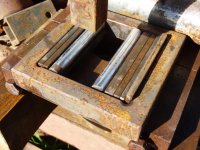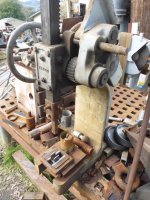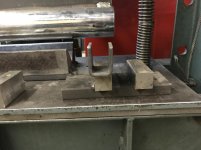M. Moore
Titanium
- Joined
- Jun 8, 2007
- Location
- Vancouver Island, B.C. Canada
Looking for some advice on constructing a simple die to make about 500 or so parts.
I did make a quick jig to make a few so I could produce a sample product and it worked but not great.
I was getting some galling on the part and it wasn't exactly to the correct size after forming. Part was also getting stuck in the jig.
So here are the specs, material is HRFB, 3/16" x 1.5", finished part is 1" ID and each leg is about 1.5" long.
I would like a very flat bottom on the U shape and a pretty tight tolerance on the 1" dimension, not sure exactly what is achievable but +.010, - .000 would be ok, better than that if possible.
I have a 50 ton Dake press and want to use that to make these parts, I know it is slow but should be fine for such a short run I think. There is not much manufacturing in this area so it is do it myself or it won't get done.
So here are the questions, choice of material, radius on the die for starting the bend and radius on the punch, height of the die etc etc. Should I blast clean the parts before bending or after?
I have a decent assortment of machines to make this die but not really any grinding machines. I will be able to accurately cut the parts to length and prep them so after forming they are done.
Thanks for your help,
Michael
I did make a quick jig to make a few so I could produce a sample product and it worked but not great.
I was getting some galling on the part and it wasn't exactly to the correct size after forming. Part was also getting stuck in the jig.
So here are the specs, material is HRFB, 3/16" x 1.5", finished part is 1" ID and each leg is about 1.5" long.
I would like a very flat bottom on the U shape and a pretty tight tolerance on the 1" dimension, not sure exactly what is achievable but +.010, - .000 would be ok, better than that if possible.
I have a 50 ton Dake press and want to use that to make these parts, I know it is slow but should be fine for such a short run I think. There is not much manufacturing in this area so it is do it myself or it won't get done.
So here are the questions, choice of material, radius on the die for starting the bend and radius on the punch, height of the die etc etc. Should I blast clean the parts before bending or after?
I have a decent assortment of machines to make this die but not really any grinding machines. I will be able to accurately cut the parts to length and prep them so after forming they are done.
Thanks for your help,
Michael
















